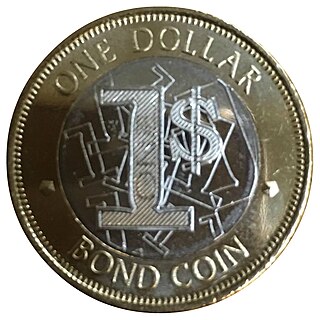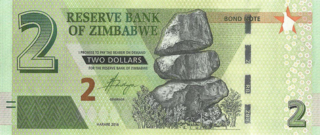
The euro is the official currency of 20 of the 27 member states of the European Union. This group of states is officially known as the euro area or, more commonly, the eurozone. The euro is divided into 100 euro cents.

The economy of Zimbabwe is a gold standard based economy. Zimbabwe has a $44 billion dollar informal economy in PPP terms which translates to 64.1% of the total economy. Agriculture and mining largely contribute to exports. The economy is set to reach $66 billion by end of 2023, 88% increase in forecast from $35 billion.

The Australian dollar is the official currency and legal tender of Australia, including all of its external territories, and three independent sovereign Pacific Island states: Kiribati, Nauru, and Tuvalu. As of 2022, it is the sixth most-traded currency in the foreign exchange market and also the seventh most-held reserve currency in global reserves.

The New Zealand dollar is the official currency and legal tender of New Zealand, the Cook Islands, Niue, the Ross Dependency, Tokelau, and a British territory, the Pitcairn Islands. Within New Zealand, it is almost always abbreviated with the dollar sign ($). The abbreviations "$NZ" or "NZ$" are used when necessary to distinguish it from other dollar-denominated currencies.

Currency substitution is the use of a foreign currency in parallel to or instead of a domestic currency.

Legal tender is a form of money that courts of law are required to recognize as satisfactory payment for any monetary debt. Each jurisdiction determines what is legal tender, but essentially it is anything which when offered ("tendered") in payment of a debt extinguishes the debt. There is no obligation on the creditor to accept the tendered payment, but the act of tendering the payment in legal tender discharges the debt.
The South African rand, or simply the rand, is the official currency of the Southern African Common Monetary Area: South Africa, Namibia, Lesotho and Eswatini. It is subdivided into 100 cents, and a comma separates the rand and cents.
The Hong Kong dollar is the official currency of the Hong Kong Special Administrative Region. It is subdivided into 100 cents or 1000 mils. The Hong Kong Monetary Authority is the monetary authority of Hong Kong and the Hong Kong dollar.

The Singapore dollar is the official currency of the Republic of Singapore. It is divided into 100 cents. It is normally abbreviated with the dollar sign $, or S$ to distinguish it from other dollar-denominated currencies. The Monetary Authority of Singapore (MAS) issues the banknotes and coins of the Singapore dollar.

The Reserve Bank of Zimbabwe is the central bank of Zimbabwe and is headquartered in Harare.

Gideon Gono is a former Governor of the Reserve Bank of Zimbabwe (RBZ), serving from 2003 to 2013, and is the former CEO of the CBZ Bank Limited.
The Zimbabwe Mint opened in 2001 with the intention of striking coins of Zimbabwe. It is located in the Bulawayo. The Zimbabwe Mint operates under the wings of Fidelity Printers and Refinery.

Hyperinflation in Zimbabwe is an ongoing period of currency instability in Zimbabwe which, using Cagan's definition of hyperinflation, began in February 2007. During the height of inflation from 2008 to 2009, it was difficult to measure Zimbabwe's hyperinflation because the government of Zimbabwe stopped filing official inflation statistics. However, Zimbabwe's peak month of inflation is estimated at 79.6 billion percent month-on-month, 89.7 sextillion percent year-on-year in mid-November 2008.

The banknotes of Zimbabwe were physical forms of Zimbabwe's first four incarnations of the dollar, from 1980 to 2009. The banknotes of the first dollar replaced those of the Rhodesian dollar at par in 1981, one year after the proclamation of independence. The Reserve Bank of Zimbabwe issued most of the banknotes and other types of currency notes in its history, including the bearer cheques and special agro-cheques that circulated between 15 September 2003 and 31 December 2008: the Standard Chartered Bank also issued their own emergency cheques from 2003 to 2004.

The Zimbabwean dollar was the name of four official currencies of Zimbabwe from 1980 to 12 April 2009. During this time, it was subject to periods of extreme inflation, followed by a period of hyperinflation.

The United States dollar was established as the world's foremost reserve currency by the Bretton Woods Agreement of 1944. It claimed this status from sterling after the devastation of two world wars and the massive spending of the United Kingdom's gold reserves. Despite all links to gold being severed in 1971, the dollar continues to be the world's foremost reserve currency. Furthermore, the Bretton Woods Agreement also set up the global post-war monetary system by setting up rules, institutions and procedures for conducting international trade and accessing the global capital markets using the US dollar.

The Reserve Bank of Zimbabwe began to release Zimbabwean bond coins on 18 December 2019. The coins are supported by a US$50 million facility extended to the Reserve Bank of Zimbabwe by Afreximbank. To date coins worth US$15 million have been struck out of the total $50 million available. The coins were first issued in denominations of 1, 5, 10, and 25 cents and are pegged to the corresponding values in U.S. dollars. A 50 cents bond coin was released in March 2015.
John Panonetsa Mangudya is a former governor of the Reserve Bank of Zimbabwe. He was appointed in March 2014 by the then Zimbabwean president, Robert Mugabe, and began his tenure as governor on 1 May that year. His second 5 year term ended on 28 March 2024. He succeeded Gideon Gono as the governor of Zimbabwe's central bank and became the nation's 6th substantial exchequer.

Zimbabwean bond notes are a form of banknote in circulation in Zimbabwe. Released by the Reserve Bank of Zimbabwe, the notes were stated to not be a currency in itself but rather legal tender near money pegged equally against the U.S. dollar. In 2014, prior to the release of bond notes, a series of bond coins entered circulation.

The Zimbabwean dollar, also known as the Zimdollar or Real Time Gross Settlement (RTGS) dollar, was the currency of Zimbabwe from February 2019 to April 2024. It was the only legally permitted currency for trade in Zimbabwe from June 2019 to March 2020, after which foreign currencies were legalised again.
















